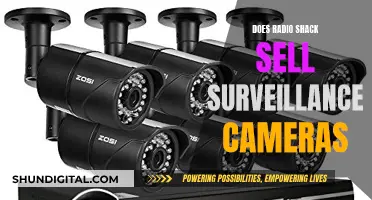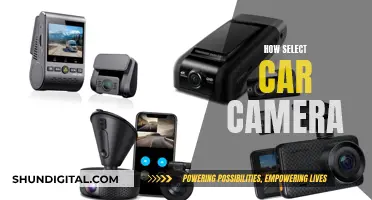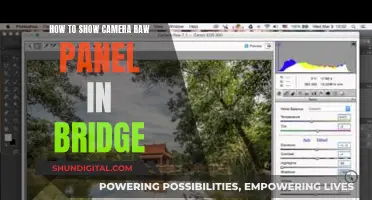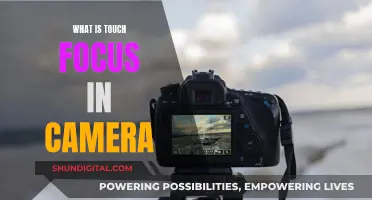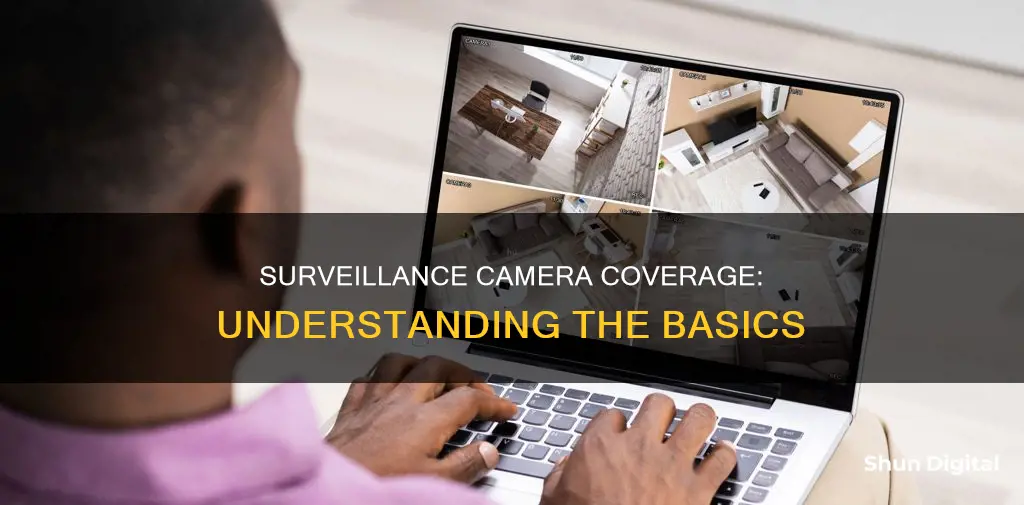
Surveillance camera coverage refers to the area that a security camera can effectively monitor. When setting up a surveillance system, it is essential to determine the purpose of the surveillance, the specific areas to be monitored, and any potential risks or obstructions. This involves considering lighting conditions, camera resolution, field of view, and the appropriate placement of cameras to ensure optimal coverage without blind spots. The type of camera, such as bullet, dome, or PTZ cameras, and the level of detail required will also influence the coverage area. By carefully planning and testing the camera placement, angle, and settings, individuals or businesses can maximise the effectiveness of their surveillance system in capturing the desired area and mitigating potential risks.
| Characteristics | Values |
|---|---|
| Purpose | Protecting property from theft or vandalism, monitoring employee activity, etc. |
| Specific area | Entrances and exits, parking lots, alleys, side streets, etc. |
| Type of activity | Theft, shoplifting, vandalism, unauthorized access, personal safety concerns, etc. |
| Camera resolution | Standard definition (SD), high definition (HD), full high definition (FHD), ultra-high definition (UHD) |
| Field of view | Depends on the width and height of the area to be covered, level of detail required, camera placement, obstructions, etc. |
| Camera placement | Bullet cameras, dome cameras, PTZ cameras, etc. |
| Camera angle | Adjust to avoid glare and reflections |
| Camera settings | Exposure, focus, etc. |
What You'll Learn

Camera resolution and field of view
The FOV is influenced by the lens size or zoom, and the distance from the objects being observed. A smaller lens size results in a wider FOV, making it suitable for general surveillance needs. Conversely, a larger lens size yields a narrower FOV, better suited for capturing fine details at a distance. The view distance, or effective range, of a camera refers to the maximum range at which it can effectively record clear images. For instance, a camera with a 2.8 mm lens and a 90-degree view angle can cover a distance of 30 feet, making it ideal for large, open areas.
Camera resolution, measured in pixels per inch (ppi), also plays a vital role in surveillance. Higher resolution cameras provide clearer images, which is essential when the camera needs to cover longer distances or capture specific details for identification purposes. The resolution of a camera depends on its physical characteristics, such as focal length, principle point, pixel size, and projection type. It is also influenced by the relative geometric relationship between the camera and the object being observed.
When selecting security cameras, it is important to consider both the field of view and resolution to ensure effective surveillance. For example, in a warehouse or large store, a wider field of view may be prioritized over fine detail. In contrast, situations requiring high-detail monitoring, such as observing a cashier's station or a secure entry point, would benefit from a narrower field of view and higher resolution.
Additionally, the height and positioning of cameras are crucial factors. Experimenting with different heights and placements can help maximize the field of view and ensure optimal coverage. The ideal height for security cameras is typically around 8-10 feet, but this may vary depending on the specific requirements and constraints of the surveillance area.
Charging the Vantop Moment 4: A Step-by-Step Guide
You may want to see also

Camera placement
- Ground-floor doors and windows: Place cameras at all ground-level entry points, including doors and windows, as these are the most common points of intrusion.
- Main stairs or hallway: Install a camera in the main hallway or stairway, as burglars would need to pass through these areas to access most of the house.
- Common areas: Secure frequently used areas such as the living room and kitchen to monitor daily activities and keep an eye on valuables.
- Driveway: An outdoor camera overlooking the driveway can capture anyone approaching the front door and help detect suspicious activity.
- Yard: Secure the front and back yards with outdoor cameras to prevent thieves from hiding out of view.
- Second floor: If you keep valuables upstairs, consider installing an indoor camera in the main hallway to capture video evidence in case of a break-in while maintaining privacy.
- Basement: If you store valuables in the basement, consider adding a camera, especially if there is a door connecting the basement to the garage.
- Garages or detached buildings: Install a camera in the garage to monitor expensive items such as cars and tools.
When deciding on camera placement, it is essential to consider federal and state laws regarding privacy and surveillance. Avoid placing cameras in areas that violate your neighbour's privacy or infringe on their expectation of privacy. Additionally, be mindful of the number of cameras you install, as too many Wi-Fi-enabled devices can affect your internet speeds.
Charging Your Coolpix S51: A Step-by-Step Guide
You may want to see also

Camera angle
When installing a surveillance camera, it is important to consider the camera angle to ensure maximum coverage. Here are some tips and factors to consider when determining the angle of your surveillance camera:
- Field of View (FOV): The field of view refers to the area that the camera can capture. It is determined by the focal length of the lens and the size of the image sensor. Wide-angle lenses offer a broader field of view, making them ideal for monitoring large areas. However, it is important to note that super wide-angle lenses may cause image distortion.
- Angle of View: The angle of view is the angle at which the camera sensor captures the environment through its lens. It is determined by the focal length of the lens and the size of the sensor. In surveillance, the angle of view is typically defined by the lens itself. Wide-angle cameras and multi-sensor cameras may require slight adjustments to the equation to account for different sensors or lenses.
- Camera Height and Position: The height and position of the camera play a crucial role in determining its coverage area. Consider the area you want to monitor and the blind spots that may exist. For example, if you want to monitor an entrance, the camera should be positioned low enough to capture the faces of people entering and exiting.
- Camera Direction: Consider the direction in which the camera will be facing. For instance, if the camera is facing an incoming flow of people, adjust the angle to capture this area while pointing away from areas that are not of interest, such as back offices.
- Fixed vs. Adjustable Lenses: Fixed-angle cameras have a set field of view and are ideal for monitoring areas where you don't need to change the viewing angle frequently. Adjustable-angle cameras, on the other hand, offer more flexibility and are useful when you need to cover multiple entrances or corridors with a single camera.
- PTZ (Pan, Tilt, Zoom) Cameras: PTZ cameras can rotate horizontally and vertically, providing a panoramic view. They also allow you to zoom in and out to capture more details. PTZ cameras are excellent for large surveillance areas as they give you more flexibility than fixed or adjustable-angle cameras.
- Fisheye and Dual-Lens Cameras: Fisheye cameras offer a wide field of view, up to 360 degrees, but often suffer from image distortion. Dual-lens cameras, on the other hand, use two lenses to provide an ultra-wide view without distortion.
- Zoom Capabilities: Consider the zooming capabilities of the camera. Some cameras offer optical zoom, which physically adjusts the focal length, while others offer digital zoom, which only adjusts the data and may cause distortion at its limit.
- Indoor vs. Outdoor Cameras: Outdoor cameras typically offer a greater coverage distance and are ideal for monitoring large outdoor areas. However, indoor cameras are designed for smaller spaces and may not be as durable or weather-resistant as outdoor cameras.
- Infrared (IR) Capability: IR capability varies from camera to camera. While most security cameras have some form of IR technology, the range can differ significantly. Consider the surveillance area and choose a camera with an appropriate IR range.
- IK and IP Protection Standards: These standards indicate the durability, water resistance, and dust resistance of the camera. Higher IK and IP ratings mean the camera is more durable and impact-resistant. These standards also impact pricing, so consider your specific needs to balance cost and protection.
When determining the angle of your surveillance camera, it is important to consider the trade-off between field of view and level of detail. Wider angles provide a broader view but may sacrifice some level of detail, especially for objects that are farther away. On the other hand, narrower angles provide a more focused view and can capture finer details but cover a smaller area.
Wiring Home Surveillance Cameras: A Step-by-Step Guide
You may want to see also

Camera type
Surveillance cameras come in a variety of types, each with its own unique features and advantages. Here is a detailed description of some of the most common camera types used for surveillance:
- Dark Fighter Technology Cameras: These cameras excel in low-light conditions, offering coloured images even in near-darkness. They are equipped with 1/2" CMOS progressive scan sensors, eliminating the need for an extra light source. This makes them ideal for night-time surveillance. They also include smart features such as line crossing, audio, and face detection.
- ANPR and LPR Cameras: ANPR stands for Automatic Number Plate Recognition, while LPR stands for License Plate Cameras. These cameras are used to read and store data on vehicle registration plates, making them useful for tolling, hotel overstay management, and parking security. They help obtain critical information in high-traffic areas to secure any premises.
- Internal and External Dome Cameras: Dome cameras are commonly used for both indoor and outdoor surveillance. Their distinctive dome shape makes it difficult for onlookers to determine the camera's orientation, creating uncertainty for potential criminals. They are easy to install, vandal-resistant, and well-suited for environments that tend to get dirty, such as warehouses.
- Bullet Cameras: Bullet cameras are long and cylindrical, designed for outdoor use, and ideal for applications requiring long-distance viewing. They are installed within protective casings, shielding them from dust, dirt, and other elements. Bullet cameras are typically mounted with brackets and come with fixed or varifocal lenses depending on their intended use. They offer high-quality image resolution and a compact size that aids in installation.
- C-Mount Cameras: C-mount cameras provide the flexibility to change lenses to suit different applications. They can cover distances beyond 40 feet by using special lenses, whereas standard CCTV lenses are limited to 35-40 feet. C-mount cameras are effective for indoor use and can support technological changes. However, their bulky size makes them noticeable.
- Day/Night Cameras: Day/Night cameras are versatile, capable of operating in both indoor and outdoor conditions with low-light environments. They are equipped with IR illuminators and an IR filter that detects decreasing light levels, ensuring effective monitoring regardless of lighting conditions. They are well-suited for monitoring exterior areas around facilities.
- PTZ (Pan/Tilt/Zoom) Cameras: PTZ cameras offer a wide range of motion, allowing them to be moved left, right, up, and down, and zoomed in or out. They are commonly used in situations where a live guard or surveillance specialist is operating the security systems. PTZ cameras provide high-quality image resolution and can be controlled through a joystick or software. They can be programmed to run patterns, turn to preset positions, and offer intelligent video analytics capabilities such as auto-tracking movement and object counting.
- Wide Dynamic Cameras: These cameras can balance light levels on a pixel-by-pixel basis, allowing them to monitor a wide area with excellent detail. They can handle a range of lighting levels within the same monitoring area, making them ideal for parking lots, sunny areas, and places with headlights. Wide dynamic cameras can capture clear face shots even with dark shadows or bright backlighting.
- IP Security Cameras: IP cameras connect to a network and use the Internet Protocol (IP) to transmit a digital signal. They offer a variety of shapes and resolutions, ranging from VGA to 4K. IP cameras tend to have built-in video analytic software, making system management more accessible. They are suitable for both domestic and commercial surveillance needs.
- Thermal/Infrared Cameras: Thermal or infrared cameras use heat to differentiate between objects and the environment. They are ideal for harsh or dark environments and can detect intruders at distances of up to 250-300 meters. These cameras can see through visual barriers and work in complete darkness, making them a top choice for airports, seaports, and critical infrastructures.
Surveillance Cameras: Gas Station Security Footage Retention Times
You may want to see also

Surveillance purpose
Surveillance cameras are used for monitoring behaviour and gathering information. Surveillance is used by citizens, governments, criminal organisations and businesses.
Surveillance cameras are used for the purpose of observing an area. They are often connected to a recording device or IP network and may be watched by a security guard or law enforcement officer.
The purpose of surveillance is to gather information, influence, manage or direct. This can include the observation of an area or person from a distance, or the interception of electronically transmitted information.
Crime Prevention
Surveillance cameras are widely used to prevent and solve crimes. They are used in public and private sectors, such as schools, homes or public spaces. Surveillance cameras can act as a deterrent, and they provide material evidence for criminal investigations.
Surveillance can be used to identify and track individuals, and to monitor their movements. Facial recognition technology is often used to identify individuals, and this technology is becoming more advanced and accurate.
Protection
Surveillance cameras can be used to protect neighbourhoods, processes, people, groups or objects.
Intelligence Gathering
Surveillance is used by governments for intelligence gathering and espionage. It is also used by businesses to gather intelligence on criminals, competitors, suppliers and customers.
Surveillance in the Corporate World
Corporations monitor individuals' behaviours for business, legal or curiosity reasons. This is known as corporate surveillance. Data collected is often used for marketing purposes or sold to other corporations.
Surveillance and Safety
Supporters of surveillance systems believe that they can help protect society from terrorists and criminals. They argue that surveillance can reduce crime by deterrence, observation and reconstruction.
Surveillance and Privacy
Critics of surveillance systems argue that they violate people's privacy and civil liberties.
Polaroid 600 Camera: Battery Placement Guide
You may want to see also
Frequently asked questions
Surveillance camera coverage refers to the area that a camera can effectively monitor and capture footage. It involves determining the optimal placement and settings for the camera to ensure adequate coverage of the desired area.
To calculate the appropriate coverage area, you need to consider the purpose of surveillance, the specific areas to be monitored, potential risks, lighting conditions, obstructions, and the desired level of detail. You can use online tools and calculators to determine the best camera placement and adjust the camera's resolution, field of view, and angle to ensure optimal coverage.
When choosing a surveillance camera, consider the type of camera (e.g., bullet, dome, PTZ), the desired level of detail (resolution), lighting conditions, potential obstructions, and the distance between the camera and the area to be monitored. It's also important to decide whether you need optical or digital zoom capabilities.
The best height for indoor surveillance cameras is typically around the 10-foot level or higher. This height keeps the cameras out of reach for most people and reduces the risk of tampering. However, it's important to ensure that the camera's view is not obstructed by large windows or exterior doors, as sunlight can affect the image quality.


